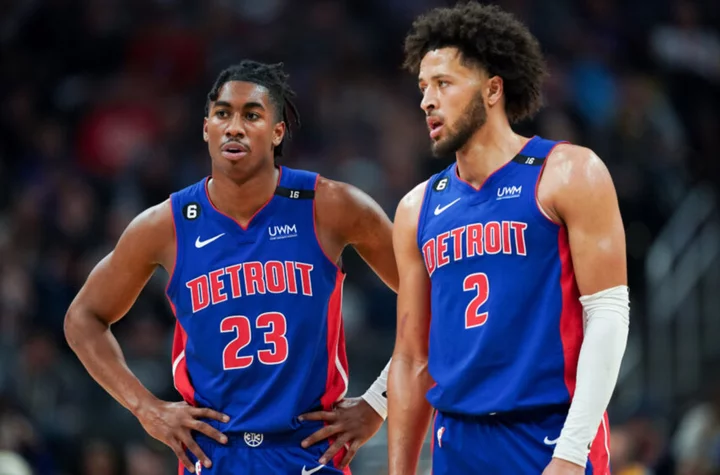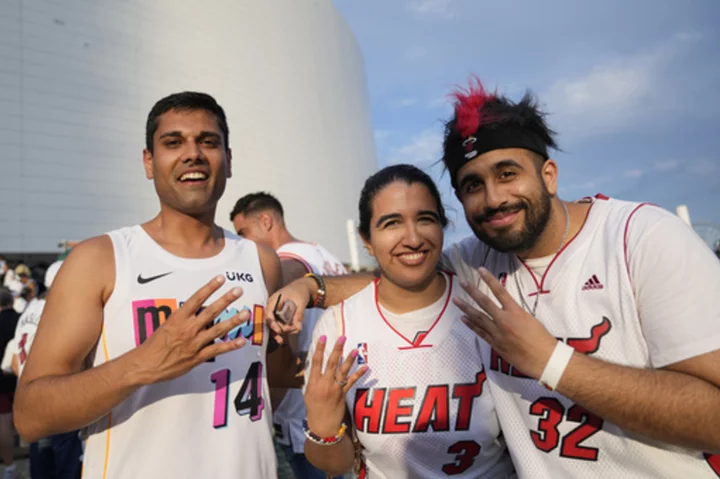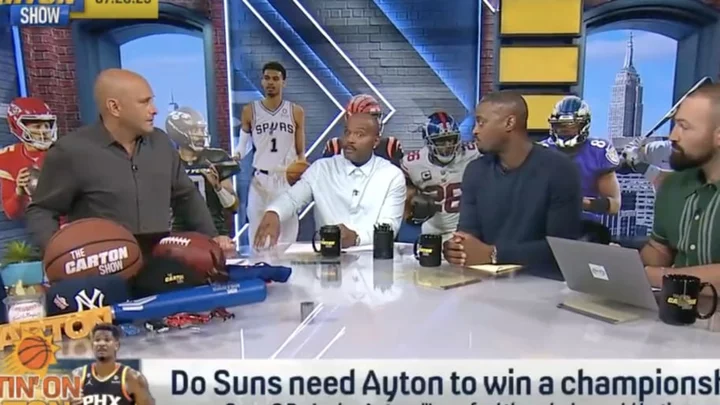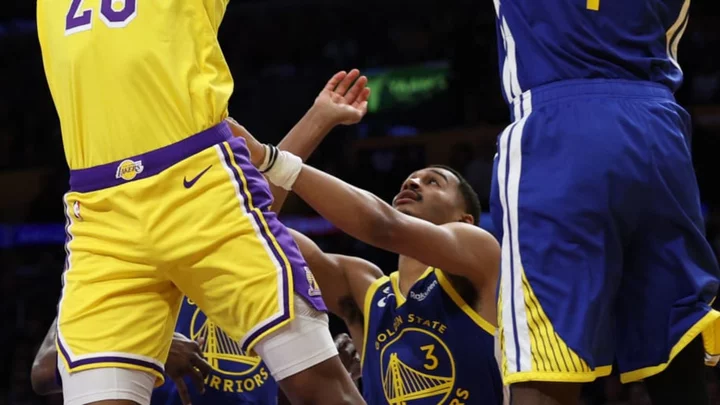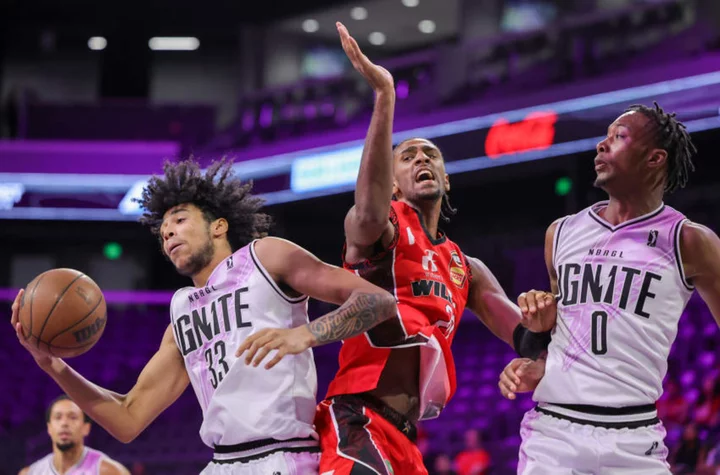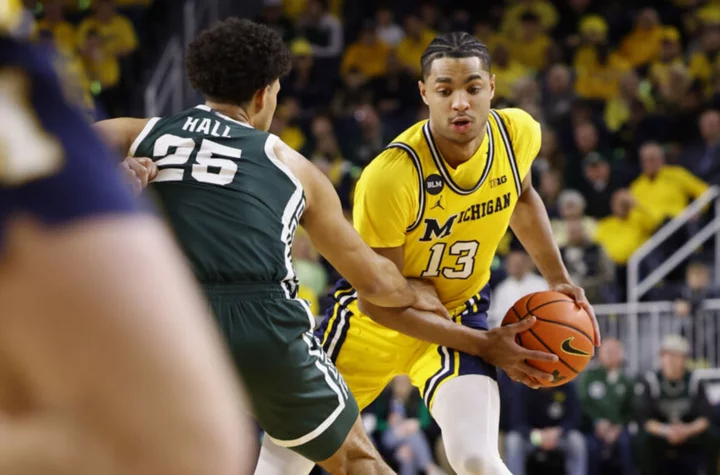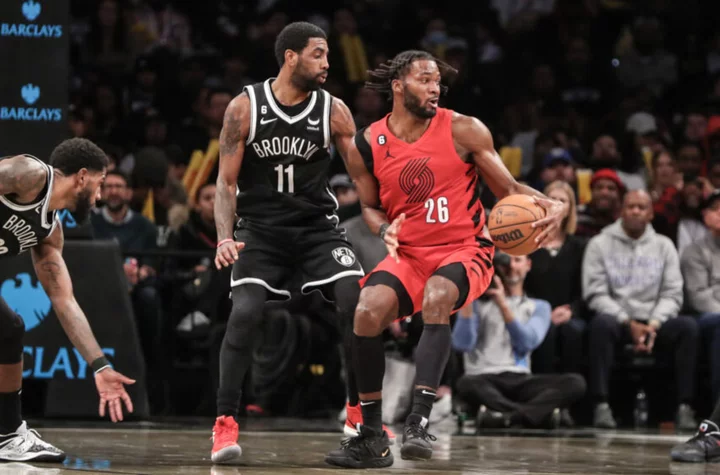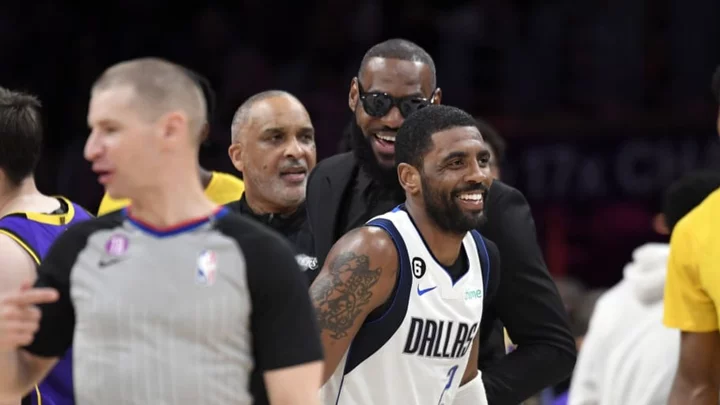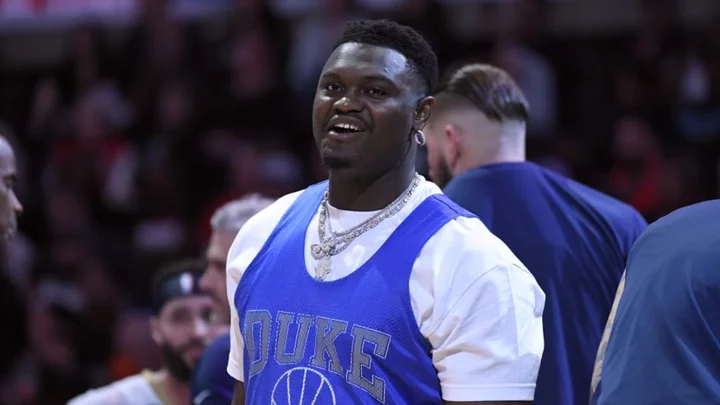The Detroit Pistons finished last season with the worst record in the NBA. Cade Cunningham's return, along with the arrival of No. 5 pick Ausar Thompson, could change the team's fortunes.
The Detroit Pistons were the worst team in the NBA last season. Such is life for a tanking team, of course, but the Pistons weren't run-of-the-mill tankers. Former No. 1 pick Cade Cunningham, in his second NBA season, played only 12 games because of injury. That put a wall between the Pistons and progress.
Cunningham's return infuses the 2023-24 season with more optimism. The Pistons saw massive in-season improvement from 2022 lottery pick Jaden Ivey. Meanwhile, Jalen Duren was one of the most productive rebounders in the NBA as a rookie. Bojan Bogdanovic is a talented veteran who, if nothing else, will furnish the Pistons with another first-round pick or two once the trade deadline arrives.
The big new arrival for Detroit this season is Ausar Thompson, the No. 5 pick in June's NBA Draft. While the Pistons' fall from No. 1 to No. 5 on lottery night was a keen source of pain for the Detroit faithful, this was a good year to fall. Thompson will immediately become one of the most impressive perimeter athletes in the NBA. He's not perfect, but he's a future star who can make plays all over the floor, as evidenced by a productive Summer League stint.
The Pistons will operate under a new head coach this season. The Pistons shelled out a six-year, $78.5 million contract to lure Monty Williams to the Detroit sideline. Williams went to the Finals with Phoenix in 2021 and is one of the most respected coaching voices in the league. His wisdom and character will work wonders in a young locker room. He's a natural leader and he's a great option to chart Detroit's path to relevancy in the Eastern Conference.
As the new season dawns, here's what Williams is working with rotationally.
Detroit Pistons starting point guard: Cade Cunningham
Cade Cunningham's rookie season was a marvel. He averaged 16.4 points, 5.5 rebounds, and 5.6 assists on .416/.314/.845 splits in 32.6 minutes. His numbers were up across the board last season before injury struck. Now he's primed for a huge breakout in 2023-24. The Pistons are still in the early stages of their rebuild, but Cunningham is the foundation upon which the next decade of Detroit basketball will be built.
This is a man who drew Luka Doncic comparisons before the draft. Those were always deeply unfair to Cunningham, but the Oklahoma State product does fit an archetype that is naturally appealing in the modern NBA. At 6-foot-7, he's a wing with a point guard's mind. Cunningham can defend one through four and run the offense. He's not blessed with elite burst or explosive finishing, but he's strong, skilled, and above all else, immensely clever.
Cunningham will need to improve his efficiency, but he is a potent pull-up shooter out to the 3-point line with a combination of strength and touch that makes it easy to buy him as a finisher around the basket. Cunningham operates with tremendous poise and patience in the pick-and-roll, subtly forcing his defender off balance with shifting speeds and side-to-side handles before uncorking beautiful skip passes or skating to the rim for a bucket.
The Pistons should continue to place stock in Cunningham as the No. 1 option. There have been roadblocks, but he's one of the best prospects in the NBA and he's still 21 years old. The Pistons have been willfully patient. As Cunningham grows and builds up a rhythm, the team around him will improve. Not many players come along with Cunningham's intersection of size, skill, and intelligence. He's special.
Primary backup point guard: Monte Morris
Monte Morris is the epitome of a "steady hand." He hardly ever turns the ball over. He averaged 5.3 assists to only 1.0 turnover in 27.3 minutes with the Wizards last season. Morris also scored 10.3 points on efficient .480/.382/.831 splits. He's a comfortable 3-point shooter who can work on or off the ball. He processes the game quickly, plays within the offense, and frequently elevates teammates.
Monty Williams will absolutely love him. The Pistons are young. Youth generally means erraticism and mistakes. Morris is the perfect tonic. He can steer the ship through turbulent waters, place teammates on the same page, and keep the offense running smoothly when called upon. He also defends his position well.
Other players who could receive minutes at point guard: Killian Hayes, Alec Burks, Jaden Ivey, Marcus Sasser
Killian Hayes was the No. 7 pick in the 2020 NBA Draft. Yours truly had him No. 2 on his personal board. Hayes has not delivered on the hype, but he continues to flash just enough potential to keep Detroit fans invested. The fanbase is running out of patience, but Hayes is 6-foot-5 with long arms, an aesthetically pleasing (if inconsistent) step-back jumper, and some real playmaking juice. He plays both ends. If the jumper ever hits on a regular basis, he will be a real player.
Detroit Pistons starting shooting guard: Jaden Ivey
Jaden Ivey was excellent in his rookie season, especially after the All-Star break. He lived up to his billing as the No. 5 pick and figures to be a central figure in the next decade of Pistons basketball. We didn't get to see much of the Ivey-Cunningham backcourt, but what we did see was enough to establish a strong foundation for optimism.
In many ways, Ivey is the perfect complement to Cunningham. He's an open-court speedster who loves to get out on the fast break. Cunningham loves to kickstart fast breaks with rebounds and hit-ahead passes. Cunningham operates with a deliberate, side-to-side rhythm. Ivey catches and attacks downhill with 99th-percentile speed and agility, putting frequent pressure on the rim.
Ivey will need to improve his 3-point numbers over time (34.3 percent on 4.7 attempts), but the volume is there. He averaged 16.3 points and 5.2 assists on 52.8 TS%, with much of the season spent as Detroit's top guard and No. 2 scorer. The efficiency wasn't great, but that's the case with the vast majority of rookie guards. As Ivey gets more comfortable with NBA physicality and the breakneck speed of the game, he will improve in the turnover department, draw more fouls, and take better shots. Cunningham should also give Ivey a considerable boost in all those areas.
While not the best defender as a rookie, Ivey is a springy athlete with ample potential to develop into a defensive playmaker. He's stronger than most guards his size at the point of attack and he should eventually become a regular infestation in opposing passing lanes. Ivey is a star on the rise and the Pistons should be thrilled about his incoming second-year leap.
Primary backup shooting guard: Alec Burks
After bouncing around the last several years, Alec Burks appears to have found a real home in Detroit. That home could vanish in an instant — he's still a vet on a young team, with plenty of potential suitors at the trade deadline — but Burks was central to the Pistons' offensive execution last season.
The arrival of Cade Cunningham and No. 5 pick Ausar Thompson, plus whatever leap Ivey makes, will cut into Burks' playing time and importance. That said, Burks should continue to supply value as a volume 3-point shooter whose role within the offense is flexible. Burks can run point and initiate sets, or he can work off the ball as a spacer and slasher. He's also big enough, at 6-foot-6 and 214 pounds, to defend a few positions and survive in three-guard lineups.
Other players who could receive minutes at shooting guard: Ausar Thompson, Cade Cunningham, Joe Harris, Marcus Sasser
Detroit Pistons starting small forward: Bojan Bogdanovic
Bojan Bogdanovic was the unlikely hero of Detroit's injury-ravaged 2023 season. He will take on more of a sidekick role with Cunningham back to full strength, but the Pistons will still rely heavily on Bogdanovic's shot-making from the wing. He's a steadying presence for a young group and he figures to have the immediate respect of new head coach Monty Williams.
Bogdanovic was his typically efficient self last season, with averages of 21.3 points and 3.8 rebounds on .488/.411/.884 splits. He attempted six 3-pointers per game and hit them at a prodigious rate, all while providing a regular helping of drives to the rim and pull-up middies.
While Bogey doesn't provide much value beyond his scoring, he's an extremely gifted specialist. His counting stats will decrease as his volume decreases, but his percentages should remain sky-high as he receives more assistance in the playmaking department.
Meanwhile, Bogdanovic will tend to difficult defensive assignments on the wing. He has lost more than a step on defense at 34 years old, but the not-so-old heads will remember Bogey checking LeBron during the King's famous postseason bouts with Indiana. The Pistons can also hand some more challenging matchups off to Cunningham and the newly-arrived Thompson.
Primary backup small forward: Ausar Thompson
Speaking of which, Ausar Thompson figures to play an important role in his first season with the team. Some outlets expect him to start, and eventually, that's where Detroit should end up. Thompson is a tantalizing offensive and defensive fit next to Cunningham and Ivey in the backcourt, listed at 6-foot-7 with tier-one athleticism and elite playmaking instincts on both ends.
For now, however, the Pistons simply have too many bigs. Thompson is a rookie who doesn't shoot from the perimeter and he will require an adjustment period. He won't have many on-ball duties if Cunningham and Ivey stay healthy, but Thompson is a brilliant connective passer who should thrive as a transition outlet with his speed in the open court. He's a nimble ball-handler too, more than capable of running the show when called upon. His jumper needs work, but there have been positive flashes.
Thompson was an absolute beast on the defensive end in Summer League. That only means so much, but he's a long and bouncy athlete who gets after it. He's quick enough to mirror the best guards at the point of attack, explosive enough to block shots from the weak side, and slippery enough to leave the opposition seeing his apparition in passing lanes. Expect a lot of stocks.
Other players who could receive minutes at small forward: Joe Harris, Isaiah Livers, Cade Cunningham
The Pistons took on Joe Harris as a salary dump, but he's an experienced veteran who shot 42.6 percent from 3-point range last season. Harris remains one of the most reliable spot-up shooters in the game and one has to imagine Monty Williams will derive value from that, especially with Cunningham's playmaking back in the mix.
Detroit Pistons starting power forward: Isaiah Stewart
The Pistons signed Isaiah Stewart to a four-year, $60 million extension to keep him with the franchise through the 2027-28 season. That investment will probably mean a starting job, at least to open the season. One of Troy Weaver's first moves as Pistons GM was to select Isaiah Stewart 16th overall in the 2020 NBA Draft and every move since then has reaffirmed Detroit's affinity for players like Stewart.
Detroit prioritizes true big men more than most teams in today's NBA. There is a comical number of traditional centers on the roster. Stewart would play exclusively the five almost anywhere else, but not with the Pistons. Stewart is going to start and close a lot of games at power forward, especially with last year's second lottery pick, Jalen Duren, coming along so quickly.
One key element of Stewart's development — especially if he's going to stick as a four — is his 3-point shot. Last season, he went from a career average of less than one attempt per game to 4.1 attempts per game. Stewart hit 32.7 percent of those attempts. Not great, but certainly not terrible and a definite sign of growth. If Stewart can become a legitimate stretch big, that greatly improves the long-term viability of him as a member of the starting five.
Stewart will earn the bulk of his credit as a defender and rebounder. He averaged 8.1 rebounds in 28.3 minutes last season. His intensity on the defensive end and competing for rebounds is seldom matched. Stewart doesn't rack up a ton of steals or blocks, but he's an absolute tank who can stonewall drives or keep bigs from establishing position in the post. The other side of the coin, however, is that Stewart is a 6-foot-8, 250-pound big who shot 44.2 percent from the field last season. Not great.
Primary backup power forward: Marvin Bagley III
The Pistons took on Marvin Bagley as a reclamation project after the former No. 2 pick struggled to carve out a role with the Kings. It has been pretty successful, to the point that Detroit signed him to a three-year, $37.5 million extension before last season. Detroit will have to get picky about which bigs to invest in eventually, but Bagley has certainly looked the part of a viable rotation piece.
The defense remains a point of concern, which is partially why Bagley gets pegged in the four spot. He doesn't protect the rim much at all. Rebounding has always been Bagley's strong suit, and he's a fairly prolific (if at times inefficient) post scorer with a deep bag of old-school tricks he can rely on. The Pistons will continue to give him plenty of burn in the frontcourt.
Other players who could receive minutes at power forward: Bojan Bogdanovic, Isaiah Livers, Joe Harris
Detroit Pistons starting center: Jalen Duren
There will be other options discussed here, but there's no way Detroit can keep Jalen Duren with the second unit after last season. Duren made an immediate and pronounced impact on the Pistons despite being the literal youngest player in the NBA. He was comically proficient on the glass (8.9 rebounds in 24.9 minutes) and highly efficient at the rim (9.1 points on 64.8 percent shooting).
The Pistons have the strength advantage in almost every matchup now. Between Duren and Stewart, few teams are packing as much muscle in the frontcourt (and that's without taking into account Bagley, James Wiseman, and Detroit's burlier perimeter players). Duren manhandles most players on the boards. Defensively, he's a towering rim protector blessed with a 7-foot-5 wingspan. On offense, he's mostly unstoppable once he catches it near the basket.
Duren doesn't offer a ton of offensive flexibility outside the paint, but Detroit experimented with face-ups and new looks in Summer League. How much of it translates to actual NBA action is yet to be seen, but Duren can exert a massive influence on winning without creating his own shot or splashing 3s. He's going to catch a ton of lobs from Cunningham and the defense will only get better as he learns more about the NBA game. He's still 19 years old on the verge of his second NBA season. Duren is young.
The upside here is off the charts. There simply aren't many players as young as Duren who make such an immediate impact. Few players in the history of the game have been as physically developed as Duren at 18 years old. The Pistons should continue to tap into that wellspring of potential next season.
Primary backup center: James Wiseman
Another former No. 2 pick turned Pistons reclamation project, James Wiseman arrived in Detroit last season and was immediately elevated from the G-League to a starting gig. He delivered statistically: 12.7 points and 8.1 rebounds in 25.2 minutes. Detroit will continue to give him ample run in 2023-24, but presumably, he takes a backseat to the (clearly superior) Duren.
The Warriors made Wiseman the centerpiece of their failed "two timelines" approach because of his monstrous athletic ability at 7-foot-1 and 240 pounds. Wiseman explodes vertically for sky-scraping dunks and his sheer length provides a deterrent at the rim. That said, Wiseman is a remarkably inefficient finisher for a player with his size, strength, and mobility. He also struggles to defend in space. Frequently, he's out of position entirely on defense.
That's not to say Wiseman can't develop into a reliable two-way force, but he has long been more theoretical than actual. The Pistons will hope that changes, but right now Duren is much further along and three years younger.
Other players who could receive minutes at center: Marvin Bagley III, Isaiah Stewart

